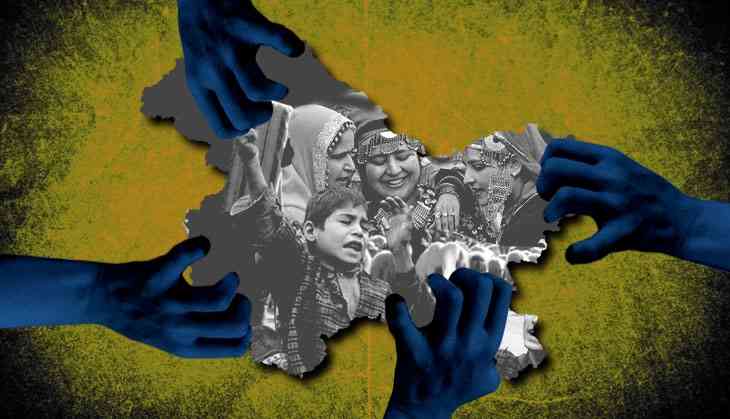Apprehension, cynicism and anger: The many moods of Kashmir today

A friend and sensitive politician asked me: “Tell me, very simply, what is the mood in Kashmir?”
Such questions – often rare – directed to us in Kashmir are welcome. More often, they provoke thoughtful responses.
Here is my response to the question: there are three moods that one readily detects. Each can be likened to a hole that Delhi has been digging for itself, arguably since the very beginning of the dispute over the Jammu & Kashmir state.
They are not new, but what is unique about the moods today is that they prevail in all the three regions of the state, across ideological divides and intersecting religious rifts.
For Delhi, this should represent a dangerous impasse from which, unless it is careful, it will “reap the whirlwind”, to quote the words of a former BBC journalist.
Deep apprehension
The first mood is that of deep apprehension. This attitude is representative of those whom Delhi would call the ‘moderate voices’ of Kashmir, a category that is often a euphemism for people who ‘think like Delhi’ and therefore don’t represent an existential threat to integral India.
This segment of the society – the establishment-approved political parties, those genuinely bound to India by plurality in kinship and those invested in it emotionally – is today profoundly uneasy that they may be backing the wrong horse and have begun to doubt Delhi’s intentions for Kashmiris.
In regional reactions, the brutal response of the Indian security forces to the unarmed protests of 2008, 2010, 2016, and now in 2017, have provoked sceptical questions even among confirmed Indian nationalists of Leh district, which is coming closer to the sentiments of protest already overtly being expressed in Kargil District. And this in Ladakh, considered the eastern bastion of Indian nationalism in the state.
In Jammu’s Chenab Valley and along the Pir Panjal, the emboldening pronouncements of the military’s strong arm tactics in Kashmir by military leaders, prominent politicians and uncivil segments of society are sowing the seeds of doubt that has less to do with confessional preference and more with its meaning for political existence.
Deep cynicism
The second attitude is that of deep cynicism that is felt amongst those who used to be called ‘the silent majority’ - that is, people who are not inclined to track politics and react to its quotidian shenanigans in the scant space provided between political tomfoolery and academic political analysis.
This segment of society is habituated to expressing itself only during elections, but otherwise is busy earning an honest living or anxiously trying to make ends meet. They have started to speak the negativist language of the cynic.
Cynicism rears its head when hope wanes. In politics, this in part is verified by dwindling numbers during elections. The last in Kashmir, a by-election close on the heels of the brutal summer of 2016, evoked a response of a turnout of 7% and 2% in two attempts.
That fact is not a hint for Delhi’s consideration, it is a dire warning amounting to a near-shove at the edge of a precipice. But it is a forewarning the government refuses to heed. You can fool all the people some of the time (consider 1947 to 1988), and some of the people some of the time (consider 1989 to 2007) but not all the people all the time (consider 2008 to 2017).
Deep anger
The third palpable temper in Kashmir today is that of deep anger.
Overtly, this is expressed by Kashmir’s youth, who are politically among the most eminently educated segment of society in South Asia.
But this mood is today also present, unmistakably, among vast swathes of Kashmiri society regardless of age. They are angry because their familiarity with global trends makes them keenly aware of opportunities that are lost to them. They are angry because they are informed enough to know that their en masse future is uncertain at best and they are angry because they see that their condition is the result of being deprived of, precisely, their basic freedom: azaadi!
What is more, the pain – indeed, quite literally, deaths – of the youth in their late teens onwards is being witnessed by increasingly younger siblings, parents, grandparents, uncles, aunts, friends, neighbours and other state citizens.
Moreover, what used to be the discontent of urban activist youth has spread to a rural activist youth, who constitute the vast majority of this segment of Kashmir’s demography.
This ‘whirlwind’ cannot be halted by political deception, social media arguments or even military muscle anymore because it seeks justice for legitimate ambitions and rational aspirations that have been routinely and repeatedly thwarted by ‘the authorities’.
Staring into the abyss
I have metaphorically spoken of three holes that are being dug in Kashmir. But in real time, it is one hole which successive governments in Delhi have being digging for the last 70 years. The difference is that today all segments of society in Kashmir – the ‘moderate’, the ‘silent majority’ and the young – find themselves staring out of it.
Delhi is staring into the hole, but it needs to recognise that it is the three branches of its government – the political, the military and the intelligence agencies – have been digging that hole.
The lesson for all of them is that the first thing to do to get out of a hole is to stop digging.
First published: 22 June 2017, 16:27 IST
